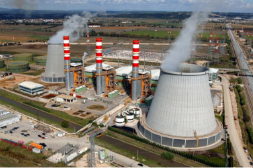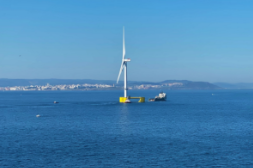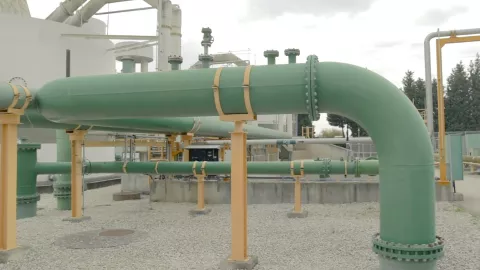The EDP Group has a new green hydrogen-focused business unit, H2 Business Unit, to strengthen leadership in the energy transition. The potential of green H2 has been widely worked on at EDP in recent years, such as the innovative FLEXnCONFU and BEHYOND projects.
EDP's bet on green hydrogen is in line with the global goals of decarbonization, but also with the cost reduction of this essential product, where competitiveness is expected to be achieved over this decade. In this way, green hydrogen will be increasingly integrated into EDP's portfolio.
Led by Ana Quelhas, H2BU - H2 Business Unit will focus its efforts on green hydrogen opportunities in sectors such as the steel industry, chemistry, refineries and cements, as well as long-haul heavy transports. Priority markets will be the United States and Europe. "If we want to meet carbon neutrality goals, we will need to use other energy vectors, such as green hydrogen, to respond to sectors where electricity is not a technically viable, or economically attractive", says Miguel Stilwell de Andrade, EDP's CEO.
It is precisely from the eyes set on hydrogen that FLEXnCONFU and BEHYOND emerged in 2020, which we detail below. Miguel Patena, Director of Innovation at EDP Production, explains the objectives of FLEXnCONFU, a project taking place in the Ribatejo Thermal Power Plant. Sofia Ganilha, BEHYOND's project manager, and Nuno Filipe, EDP NEW's project manager, unveil some details of the study for hydrogen production from offshore wind farms.

FLEXnCONFU
- FLEXnCONFU: Paving the path for plants
- FLEXnCONFU project moving swiftly
- With eyes set on transport

BEHYOND
- BEHYOND: The perfect combination of wind and water
- What are the benefits of operating offshore?
- Production according to destination
- Extended plan on the table
FLEXnCONFU: Paving the path for plants
Ribatejo Thermal Power Plant is involved in a project that could help current power plants adapt to a future in which hydrogen plays an increasingly important role in energy production and consumption chains. Comprising 21 partners - including EDP Produção and EDP NEW - and three countries (Portugal, the United Kingdom and Italy), FLEXnCONFU is expected to run until the end of 2024, and the next two years will be devoted to practical demonstrations of hydrogen use and production in the plant's natural gas turbines.
"This pilot project is small in size but grand in its significance and future purpose," says EDP Produção Director for Innovation Miguel Patena, who is also one of the people in charge of FLEXnCONFU - a project with a €12.6 million budget, 70% of which is funded by the European Union. EDP Produção contributes €2 million for the installation of the pilot project, while NEW chips in €0.3M for activities involving the dissemination and other uses of H2.
The goal is to produce hydrogen from a 1MW electrolyzer, test its storage in pressurized tanks, and then inject it into gas turbines to produce electric energy in a combined cycle plant. "This project will give us the foundations, from a technological perspective, to validate the solutions in the future and to assess whether it is worthwhile to prepare combined cycles for a higher percentage of hydrogen in natural gas," says the EDP Produção officer, adding that "the injection of H2 is symbolic, it's merely 0.1 percent" of the turbines' capacity. Nevertheless, this is enough to "make the experiment from a technological point of view and to determine whether it makes sense to scale up."
Gas turbines at EDP's CCGT plants support a mix of about 10 percent hydrogen, so "beyond that limit we have to make substantial changes, which are very expensive," says Miguel Patena. On the other hand, the government's strategy includes investing in a blend of hydrogen and natural gas. "It will happen in the coming years, and by testing this technology in a combined cycle, we will anticipate this need in the future," says Miguel Patena.
Basically, EDP also wants to "learn more about the technology and its flexibility," because apart from the electrolyzer, "all the other systems around it are made to measure" and "even the licensing for this is a new thing in terms of conventional power plants."
FLEXnCONFU project moving swiftly
Now that the initial layout and engineering stages have been completed, 2021 will be devoted to determining the technical specifications for purchasing the equipment, which is expected to arrive in 2022. The facilities at Ribatejo Power Plant are already prepared, so the next year will be devoted to installing the structures, with the first tests being carried out by the end of 2022. "Our commitment before the European Commission is to present results in 2023 and 2024, showing that H2 can burn safely and flexibly in turbines," says Miguel Patena.
Overall, 1000 hours of hydrogen will be used, which amounts to over 41 days if we consider a 24-hour production system. According to the EDP Produção Director for Innovation, this will include several kinds of operations, such as "emergency tests, starting with almost 100% hydrogen - that 0.1% in the mix -, spurts, load variations." All this "with several partners wanting to see and participate in this analysis."
FLEXnCONFU includes a multidisciplinary team, which will comprise as many as 15 people during the installation phase, but the plan is to integrate many more in the project. "It is important to involve as many people as possible," Patena says, "to carry out this internal learning so that we can be better equipped for more ambitious projects."
Miguel Patena believes that this is an important matter for the whole industry, because jobs "will be reinvented" with the energy transition process. Not least because of the innovative and cross-cutting nature of hydrogen in the future: "If we look at EDP alone, it is there in virtually all areas, whether it's renewable energy, production, or even the commercial and services areas."
With eyes set on transport
According to the EDP Produção Director for Innovation, "hydrogen is the last mile of decarbonization." Electrification is easier and more effective in general, "but there are industries, such as the heavy industry, the steel industry, and the long-haul transport industry, that need other solutions. These are the segments that may be interested in hydrogen as a cheap raw material."
And that is why other synergies are already being created at Ribatejo Power Plant - synergies that could pave the way for the post-2024 future, once the FLEXnCONFU demonstration is completed. "We got a call from Alenquer Town Hall and carried out a study with Iveco, the Town Hall and Luís Simões to test the use of H2 in transport," says Miguel Patena. According to him, "this will have to be negotiated with the consortium, but, if the electrolyzer remains in the plant, it could feed a hydrogen hub for long-haul or passenger transport in the region."
The contribution of this project's electrolyzer to the plant's power supply would never be more than "marginal," but it would be enough for other uses. Should it be decided to invest more in H2 in a combined cycle plant, "the pipeline would already bring this mix from another location," as EDP is involved in other hydrogen projects.
And even if the project does not evolve into more ambitious endeavours after its completion, its mission will have been accomplished. "Our goal is to learn lessons that can be used outside of the plant and applied to all situations in which hydrogen is needed. Learning requires experimenting," adds Miguel Patena.
BEHYOND: The perfect combination of wind and water
Some decades ago, few people would think of putting wind turbines out at sea - especially if associated with hydrogen production. Now, however, there are at least 15 offshore wind energy projects under development in Europe, and one of them - BEHYOND - is coordinated by a Portuguese company: EDP NEW.
"BEHYOND started off in late October 2020 and is a one-year project," says Sofia Ganilha, the project manager of the program, which is being carried out in partnership with engineering center CeiA, WavEC, TechnipFMC, and Norwegian university USN. The team comprises more than 40 people. "Right now we are completing the identification of the places and regions that are more likely to support the implementation of this new technology," she says, adding that the next phase will be "focused on determining the most viable and attractive business models."
But what is the purpose of BEHYOND? Why produce H2 from offshore wind? Basically, the idea is to use an "intermittent resource" - wind - for producing hydrogen, thus creating a synergy between the two resources. "This project aims to assess the feasibility not only of channeling part of the electricity generated by offshore wind farms to hydrogen production, but also of building farms entirely devoted to H2," says Sofia Ganilha.
As a feasibility study focusing both on technical and economic issues, all variables are on the table. And the initial results, according to the project manager, are quite positive: "They have been proving the attractiveness of this new hybrid model for sustainable energy generation." And Nuno Filipe, head of RES Integration & Flexibility at EDP NEW, argues that this could prove "a competitive and scalable solution, with applicability in different regions, which can be used by wind farm owners to produce green hydrogen."
What are the benefits of operating offshore?
Although it seems a rather complex process, Sofia Ganilha explains that there are several potential benefits to investing in hydrogen production at sea:
- Transferring H2 production to offshore sites ensures a more stable energy supply, making it possible to produce hydrogen more steadily.
- Replacing the electrical connection to land with hydrogen pipelines requires a smaller initial investment (high-voltage electricity cables cost more). And these hydrogen pipelines can act as an intermediate buffer/storage for the H2 that has been produced, which circumvents the need for additional on-land investment.
- There are vast maritime areas available for these implementations, which have greater public acceptance because they are far from residential, shopping, and industrial areas.
Nuno Filipe adds that the offshore environment "has better resource conditions, which ensures greater availability of generated energy; this results in lower electricity costs, which has a major impact on the final cost of hydrogen." Moreover, "there are no noise and operability restrictions at sea, which allows for greater system usage and efficiency."
As for challenges, according to the head of RES Integration & Flexibility at EDP NEW, "they involve the assembly, logistics and maintenance of offshore wind farms, as this is a recent field which still lacks specific data and information." In terms of production and transport, the "corrosive environment" should also be taken into account.
Production according to destination
At first glance, a hybrid electricity-hydrogen solution making its way to the coast would seem the most suitable for the nearest regions. And Sofia Ganilha emphasizes "the flexibility it offers, whether for safety reasons - in case of shutdown of one of the systems, it is possible to use the other - or for optimization reasons, as it is possible to focus on the production of hydrogen or electricity depending on the market's interest at any given moment." And one should not forget the possibility of using wind energy even when electricity consumption on the grid is low.
However, wind power production entirely devoted to hydrogen also has its advantages. "The implementation of solutions for the production and use of hydrogen is determined by demand in a given region," says the BEHYOND project manager at EDP Inovação, and "it primarily depends on the existence of an end user who needs to use hydrogen and/or electricity." Sofia Ganilha therefore predicts that this model could make sense in industrial areas by or near the coast, where hydrogen is or may become an essential raw material.
Extended plan on the table
BEHYOND does not provide for an on-the-ground testing phase, but this has not been ruled out by EDP or the other partners. According to Sofia Ganilha, this is because "offshore wind power has a huge potential to become an energy source for society as a whole. Several European countries have an ambitious vision for hydrogen and are willing to support solutions that are similar to those we are developing."
As for Nuno Filipe, he believes that this technology will be ready to be marketed by 2025, but "it is necessary to find other funding programs" in order to bring the project "from the proof-of-concept stage to commercialization."
Whatever the next step is, according to Sofia Ganilha, once BEHYOND has been completed, "it will allow EDP to acquire the necessary know-how to determine the viability of this business segment. Green hydrogen, produced from renewable energy sources, will become one of the main drivers of decarbonization, while also mitigating the intermittency of onshore and offshore renewable energy sources."
She also points out that "working with many major technological and academic players in the field will make it possible to build a solid foundation, and, by heading the BEHYOND project, EDP is anticipating a trend and preparing once again for the future." Nuno Filipe, on the other hand, argues that "the possibility of using this energy to produce hydrogen, rather than wasting it, ensures the production of a resource at a very low cost, which may then be used for electricity production or, even better, for direct H2 consumption where it makes the more sense - non-electrifiable end uses."



